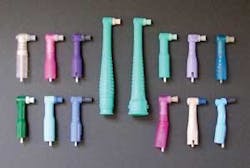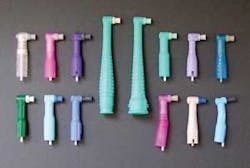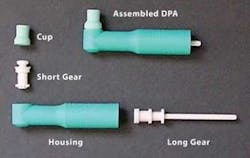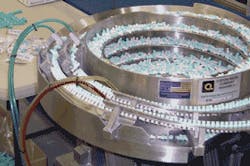What Color is your DPA?
Here’s the “need to know” and “good to know” about why your prophy head spins.
You wouldn’t say you’re a slave to mindless rituals, but you’re pretty darn close. For starters, you rise at 6 a.m. every clinical day (okay, 6:23 a.m., post-snooze button abuse). You throw on the obligatory casual, coffee-stained, travel-to-the-office attire. By 7:30 am, you’re either in your office reviewing the days’ charts, setting up your operatory, or attending a “team” meeting.
Another mind-numbing ritual might be when you attach a disposable prophy angle (DPA) to your slow-speed handpiece. Most hygienists cannot even remember its color. OK, close your eyes - what color is your DPA? And, for extra credit, what company did you buy it from?
For many practicing hygienists, the disposable prophy angle has become commonplace. We use and rely on them ad infinitum everyday. Yet we spend little, if any, time assessing the gears, advances in prophy cup technology, or the latest improvements in design. This article provides the reader with both “need to know” and “good to know” DPA information. Once revealed and retained, it could cause you to consciously and confidently rethink your DPA selection, based on something other than the color.
The secret life of a DPA
Approximately 200 million prophylaxis procedures are performed annually, and about 80 percent of U.S. dental offices use disposable prophy angles. The price range of angles is between 25 and 60 cents, and it is estimated that U.S. dollars spent on DPAs is close to $60 million. This makes disposable prophy angles the biggest selling preventive products in the United States, and we can purchase DPAs though dealers or directly through retailers.
Since I counted myself as one of the clueless masses when it came to the secret life of a disposable prophy angle, I decided to expose the best kept secret in hygiene - the manufacturing process and often overlooked prophy cup technology. My sources in the DPA world were Preventive Technologies, Inc., (www.preventech.com) and their manufacturing partners at Team Technologies. Inc.
Team Technologies, Inc., is not a familiar name in dental hygiene. They partner with other more identifiable businesses to make or build a variety of American-made products throughout a multitude of channels. Since they are a global leader in the manufacturing of disposable prophy angles, they hosted my tour of their manufacturing facility in Morristown, Tenn.
Assembly process exposed
Before disclosing the manufacturing process, let’s re-visit the “good to know” basics of DPA parts. Disposable prophy angles are made of plastic with different types of internal designs. They are built with the durability and reliability of a metal angle. The angles connect with a doriot attachment that drives the angle to the nose cone or motor. DPAs come in a variety of colors and cup flexibilities.
All DPAs consist of 4 primary parts:
▲ Housing - outer shell, grip area, and colored section
▲ Long-gear - the mandrel, which connects to the nose cone or motor
▲ Short gear - the part that anchors the prophy cup (screw or snap type)
▲ Lubrication - food grade pre-lubricant is placed at the gear connections to reduce friction
The overall process is mostly automated and involves very little hand assembly. They customize modifications to their pre-assembly and assembly machines, based on which company’s angles are scheduled for manufacturing. The process begins with the pre-assembly machine, which molds and manufactures the various components of the DPA. The plastic material must be precisely molded based on customized modifications. If the parts of a DPA are not made accurately, then failure could result when it gets into the user’s hand. With DPAs, the end user is almost always the dental hygienist.
On the surface, it looks like four simple parts; yet it actually is a high technology molding and production operation involving the stacking of hundreds of tolerances (standards) down to a thousanths’ of a millimeter. Think for a moment about all the technology that goes into your car engine, ensuring that it will operate in all conditions. That piece of equipment has a tolerance of 7,000 rpms, Meaning that if the engine operates at a higher rpm than 7,000, it can burn up! Now, understand that the plastic gear box on our DPA are manufactured to operate at 3,000 rpms during procedure after procedure without a hitch. When it comes to operating our DPA, a “need to know” is that 3,000 rpm is the average speed. Hygienists need to check and continually monitor their rpms. If your handpiece is operating too high or too low, the performance of the DPA will be affected.
Once the pre-assembly parts are quantified, they move on to the DPA assembly machine, which has a robotic arm and gigantic bowl. At this stage, the components are assembled, lubricated, and the angles become more recognizable. The next steps are the inspection, packaging, and shipping of the products.
To eliminate or minimize failures before they reach the hygienist, manufacturers use a hat-trick type of quality control process - a computerized process via the DPA machines, a daily visual process, and field tests. The computerized process utilizes an ultraviolet “eye” during the manufacturing process to inspect each angle and verify that it meets the required specifications. The daily visual or hands-on analysis occurs when a sample number of DPAs are taken and tested by employees. These employees put the angle through a “DPA boot camp” to make sure the batch can withstand the rigors of clinical use. Lastly, the corporation works with about five local dental offices and hygienists. These clinicians use the DPAs that are manufactured and provide immediate feedback if they discover any failures.
Since hygienists are end-users, if we ever had a problem with a prophy angle, a “need to know” is that we should call the company who marketed and sold them to us. By contacting the company, they can easily walk us through a series of questions to determine if the problem is actually with the angle itself or if the “freeze up” was caused by another factor, which most commonly is the handpiece.
No more paste in my hair!
The key to eliminating prophy paste in your hair is an understanding of cup technology. Cup technology deals with the manufacturing or molding process that is used to make your prophy cups, including natural rubber (latex) vs. latex-free, and the degree of firmness.
The first “need to know” in regard to prophy cups is determining if your cup is made with a plastic injection molding or a compression molding manufacturing process. The distinction of which technology is used is based on the individual company’s specifications, which is why the “need to know” is that you need to ask.
Plastic injection molding is defined as “liquid flowing into” a mold. The plastic liquid then hardens (polymerizes) and the pieces must then be broken or cut off the main mold or model. For clarity, think about a model car or airplane kit. Before assembly can begin, time must be spent “ breaking” or detaching the pieces from a main plastic grid. Sometimes, when you take a prophy angle out of its package, you can see the extra flanges around the prophy cup. This type of engineering may increase splatter and cause greater vibration.
Next, we can explore the “memory” of a prophy cup. For example, an injection molded cup - if squashed in the packaging box or in your hygiene cabinet - may not retain its original round or symmetrical shape. The cup, due to the manufacturing process, does not have a memory. It would more likely resemble a football shape or oval. This change in shape would not keep the paste inside of it. The cup’s motion would be wobbly, resembling the unbalanced tires of a car driven on the highway.
Compression molding allows the cup to hug the tooth surface because the manufacturing process provides for flareability and conformability. The cup is not “broken” off, but is molded via solid block, a mold, and a negative impression. With this technique, the cup has a memory. Using the “squashed” analogy from above, if your cup was a compression molded cup, then it would return to its original concentric and round shape, thereby retaining the prophy paste in the center. This can decrease the potential for splatter, which is ultimately important for infection control.
Compression cup molding also improves ergonomics because it creates less wobbling and vibration and provides the clinician with more control.
One fact that I found particularly intriguing is that out of the 80 percent of dental offices that purchase and use disposable prophy angles, only 25 percent use latex-free versions. With the increase in patient and hygienist sensitivity to latex, I assumed this number would be a lot higher.
Looking more closely into the category, I discovered that cups could be made from natural rubber material or latex-free material. A “good to know” is that when you use a natural rubber material prophy cup, the manufacturing process used is compression molding. Yet, when you switch to a latex-free angle, either injection or compression molding can be used.
A few hygiene colleagues have mentioned to me that they “just didn’t like the feel of the latex-free angle.” Well, the “need to know” is if you switched from natural rubber to latex-free and also switched from the compression to the injection process, it may not be the latex-free material that is the problem. The challenge is a difference in your feel and comfort level when you switched from a circular cup with a memory to a potentially non-circular cup without a memory.
If you have had problems with latex-free angles, you owe it to yourself to investigate the variety of latex-free angles on the market in order to determine optimal performance.
The last “need to know” is that not all cup firmness is created equal. I learned that 80 percent of DPA users prefer a soft cup. But, there is no standard in regard to softness. However, within the dental industry, an accepted measurement of firmness or stiffness of a material is the durometer hardness test. Drawing some parallels between the manufacturing world and the hygiene world, many hygienists may be more familiar with the radiotracer, which measures relative toothpaste abrasion on dentin (RDA) and enamel (REA).This is a valid industry-wide testing method with basic standards. The durometer hardness test can assess the hardness of something soft like our skin, to dental impression material, DPAs, and even plaster. The point is that even though each company may use it, one company’s “soft score” may be another companies “medium score.” A soft prophy cup is recommended because it requires less hand pressure (decreased hand fatigue), and it’s kinder to soft tissue. This is another area that hygienists should clinically test to determine which “soft” cup they prefer, since the degree of softness can vary among manufacturers.
I want the proof, the whole proof …
I would be remiss if I did not encourage you to begin your own search through the studies for non-manufacturer related information on disposable prophy angles. Two resources available to hygienists are the DIS laboratory evaluation and Clinical Research Associates (CRA). The USAF Dental Investigation Service (DIS) conducts extensive research of dental products. The individual product evaluations commonly include testing in the DIS laboratories and with clinical end-users at federal dental service clinics around the world. At the end of the typical six-month evaluation, DIS awards an overall rating to the product. CRA also conducts hands-on research on products and publishes the results based on the merits of the product.
Remember that the most valuable “need to know” for choosing an angle is your personal evaluation. We all have our own preferences, techniques, and working environment. Taking the time to evaluate many angles and handpieces will ensure your comfort and satisfaction with the product purchased.
By thinking about and breaking the disposable prophy angle ritual, you may discover an angle that is more reliable and durable, can decrease your cost per unit, and increase efficiency, comfort, and ergonomics. And who knows? Once you are successful with DPAs, or at least know why you use the color of disposable angle that you do, you may be tempted to update other routines and seek out more colors within your rainbow.
The author wishes to thank Bill Berry, VP, Sales and Marketing, Preventive Technologies; Steven Henrikson, President/CEO, Gene Damico, VP, Marketing and Sales and Danny Seale of Team Technologies, Inc., for their expertise, time and hospitality.
The author did not receive compensation for any product or company placement.
Advantages of disposable prophy angles
■ Advances in design
❏ DPA lighter than metal
❏ Contra Angles available
❏ esa® (www.preventech.com) replaces the metal nose cone, eliminating the need to clean, lubricate, sterilize, cover and/or repair that part of the handpiece at a lower overall cost
■ Economical in comparison to metal cups
■ Ergonomically beneficial - lighter in weight, reduction in hand fatigue
■ Latex-free options are available
■ May reduce the potential for cross contamination
■ Reliable and durable
■ Single-use device only: eliminates the need to clean, lubricate, and sterilize between patients
■ Some brands are pre-packaged along with the prophy paste
■ Time saver reduces processing time and effort
DPA breakdown
How your slow-speed can cause it
▲ Poorly manufactured and/or balanced slow-speed hygiene handpiece
▲ Speed is higher than 3,000 rpm
▲ Limited maintenance schedule
▲ Sterilizing a handpiece that is not sterilizable
Kristine A. Hodsdon, RDH, BS, has gained her wings with 21 years in the industry, tackling everything from dental assisting, clinical hygiene and adjunct teaching to international speaking/ writing and success in sales. She is the Director for RDH e-Village, an online newsletter published by the PennWell Corporation. She currently speaks and consults on hygiene products and marketing, speaking skills, and the future of dental hygiene. Kristine is a proud member of the NSA, ADHA, IFDH, IADR, and ACCD. To schedule Kristine to speak or to discuss consulting possibilities, contact her by e-mail at [email protected] or visiting www.kristinehodsdon.com.



